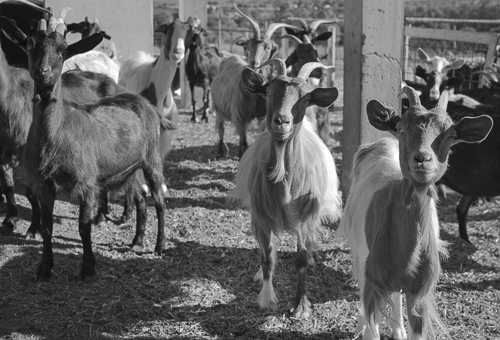We are on the island of Sant’Antioco connected to Sardinia by means of a bridge, near the town of Calasetta, situated along a slope in the north-west of the island and partially encircled by white beaches and the sea. The ancient name of Calasetta, Cala di Seta, meaning Bay of Silk derives its name from production of sea silk, a marine type of silk which is extracted from a bivalve mollusc called Pinna nobilis.
The Tupei farm and guesthouse is located in the hillside above Calasetta, about 2 km from the town and about 1200 m from the sea. It was bought by Michele and Silvana Puxeddu in the 1990s, both of who weren’t working as farmers in advance. He was setting up dropped ceilings and wall decors, while she was working with graphics for advertising. Having decided to change their lifestyles completely, they left their jobs and selected a life following age-old traditions and offering hospitality to their guests.
Having parked at the entrance of the Tupei property, we first passed a group of horses looking at us expectantly before meeting Silvana, Michele and their dog Aprile. In addition to horses, they also raise goats, almost all them very curious when we visited them. They also had a few chickens which were free to go wherever they wanted. Besides, they are cultivating olives, vines, vegetables and fruits organically, all of which are served in the guesthouse.
Being very conscious and attentive, Silvana and Michele had decided before our arrival to join a project intending to let farmers themselves control their own seeds. Instead, the international development tends towards multinational companies selling the same types of seeds to farmers, minimising diversity, and requiring pesticides made by other multinational companies.
Luckily, at the same time as our short visit to the island of Sant’Antioco, a group of courageous women from a local agency called Laore, which occupies itself with rural development and an organisation called Domusamigas arrived shortly after us, bringing many types of seeds in their car in order to start the project. On our walk to a nearby field, they explained that Michele and Silvana had decided to take part in a genetic and evolutionary improvement of seeds developed and selected by the renowned professor Salvatore Ceccarelli with the objective to turn control of seeds to farmers, safeguarding local seeds and increasing biodiversity.
Having arrived at the field, which was already prepared by Michele, he set out to divide it into 40 equally sized rectangles being helped by the women from Laore and Domusamigas together with my guide. Using a masonry chisel and a mallet, he hammered the chisel into the ground near one corner of the field, then using a tape measure, he located the second corner of the plots. Next, he started making a line perpendicular to the first line. In order to verify that the lines were perpendicular, he and one of his helpers used the Pythagorean theorem. Actually, it was a pleasure to see this theorem applied to a real problem for the first time in my life. Having ascertained the angles and the dimensions, the women poured chalk along each line. Unfortunately, the planting of the seeds would take place another day, meaning that we couldn’t be present. All in all, 17 types of seeds should be planted, two of them local and two hybrids, some of them new, some of them old. All in all, three farms in Sardinia participate in this project and it will be done for several years.
The objectives of the project in which Silvana and Michele participate are the following:
- rediscover the evolutionary capability of local seeds.
- hand back production and selection of seeds to farmers.
- learn new techniques in order to increase biodiversity without using artificial fertilisers.
- promote and facilitate collaboration between research institutes and farmers.
- identify which seeds are most adapted to this land and environment.
- reproduce and improve ancient seed varieties leading to increased biodiversity, autonomy and better health for farmers due to not using pesticides.
- let the plants create new varieties by cross-breeding like what has happened since agriculture began.
Professor Ceccarelli is known for his programmes of genetic improvement in which farmers are selecting and planting seeds together with scientists. The work of professor Ceccarelli together with other scientists, the International Center for Agricultural Research in the Dry Areas (ICARDA), has led to greater biodiversity and larger yields of crops in dry areas
According to him we have to learn that “the seed is the foundation of life, food, and agriculture. However, farmers, who have been safeguarding and improving seeds since agriculture began, have been excluded from the production of seeds in the space of a few years. This exclusion has harmed everyone: farmers, agricultural research, our diets and the earth’s biodiversity. We have to make farmers cultivate various types of seeds for biodiversity, for themselves, for a secure food supply, and for the future”.
We are grateful to Silvana and Michele Puxeddu for their hospitality and generosity and for letting us be present at such an important moment in their lives.

